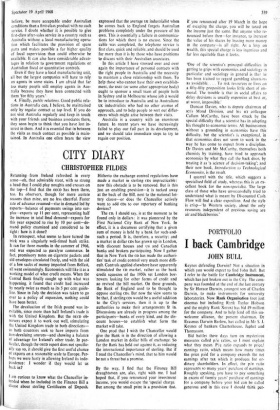I back Cambridge
PORTFOLIO
JOHN BULL
Keynes defending Darwin? Not a situation in which you would expect to find John Bull. But I refer to the battle for Cambridge Instrument, which has just broken out in the City. The com- pany was founded at the end of the last century by Sir Horace Darwin, youngest son of Charles Darwin, to make instruments for university laboratories. Now Rank Organisation (not just cinemas but including Rank Taylor Hobson and the mighty Rank Xerox) has bid f9 million for the company. And to help fend off this un- welcome alliance, the present chairman, Dr Erasmus Darwin Barlow, has called in Mr S. J. Keynes of bankers Charterhouse. Japhet and Thomasson.
Bid battles these days turn on mysterious measures called p/e ratios, so I must explain what they mean. P/e ratio expands to price/ earnings ratio, which means how many times the price paid for a company exceeds the net earnings after tax which it produces for or- dinary shareholders. In effect, the p/e ratio represents so many years' purchase of earnings. Roughly speaking, you have to pay something in excess of twenty years' purchase of earnings for a company before your bid can be called generous and in this case I should think per- haps something in excess of twenty-two or twenty-three times is required.
How does the Rank bid size up to this yard- stick? On the face of it, very well indeed. At 35s aid a share in ordinary shares and un- secured loan stock, it amounts to about thirty times latest published earnings. All the same, the Cambridge board almost immediately turned the bid down. It should be noted that the directors and their families control about 25 to 30 per cent of the equity and that the Royal Society holds another 10 per cent. Rank presumably knew this before acting and in any case does not appear to have had serious pre- liminary discussions with the Cambridge board.
Now whatever motives may explain the Cam- bridge board's decision, only one counts as far as shareholders are concerned. And that is that they must be shown that Cambridge In- strument is worth more in the market than Rank has so far offered. That means proving that profits are moving up so fast that Rank's bid of thirty times earnings is out of date, based on figures of historical interest, not in line with today's trends. The City will not stand the use of the blocking minority (which is what the Cambridge board has) by itself.
Because I believe that the Cambridge board can produce profits that make the Rank bid decidedly ungenerous, I have bought 300 of the shares at 38s 9d for my second, speculative portfolio. The downward risk is at least the 3s Ofd a share difference between my buying price and the Rank bid and probably 2s or 3s more than that if the battle is inconclusive. The upward potential, however, is, I think, good. And, as befits a speculative portfolio, the answers will have to be published within the next two months; indeed, probably rather sooner.
I base my confidence on Cambridge Instru- ment's recent reorganisation, the fruits of which have scarcely appeared yet, and upon its un- doubted export potential. The most important phase of the reorganisation started in Novem- ber 1966 when Mr Edmund Webster was brought in from Plessey as the new managing director. Early last year two more important appointments were made—one was a new sales director and the other what Cambridge calls manufacturing director.
In any case, there is an obvious possibility that another company will enter the battle in opposition to Rank. Cambridge manufactures all kinds of electrical, mechanical and elec- tronic measuring instruments, a crucial sector for the big groups working in automation and related activities. Plessey itself has been sug- gested; so has Tube Investments, with which Cambridge has a joint research programme.
For the time being, as far as the general public is concerned, there will be no action whatsoever. The first tactic is always to make the other side go to the expense ,a printing and sending out its formal offer to shareholders. This gives the defender time to gather its forces. The official reason is that, until the formal document itself is examined, there is not a precise enough proposition to which the defence can address its case.
Both -sides will keep their eyes upon the City's brand-new takeover code. It is already possible to forecast what the key paragraph will be. It is part of Rule 15 and reads: `profit forecasts must be compiled by the direc- tors with the greatest care; the calculations and the bases for the forecasts must be examined and reported on by the auditors or consultant accountants. The forecasts and assumptions upon which they rest must be corroborated, as far as possible, and reported on by the com- pany's merchant bank or other advisers. The reports by the auditors or consultant account- ants and consultant advisers shall:be made in writing to the directors. The assumptions on which the profit forecasts are based must be stated in the circular.' Upon that text, let battle commence.
Valuations at 17 Apri11968 First Portfolio Total £5,911 (details next week) Second Portfolio 100 Guardian Assurance at 42s 9d .. £214 40 Royal Exchange Assurance at 121s 3d .. £242 £2,000 GLC 7; per cent 1977 (£10 paid) at £9P6 £191 300 Cambridge Instrument at 38s 9d xd £574 Cash in hand .. • • .. £3,808 £5,029 Deduct: expenses: this week's £12 previous £15 Total £5,002







































 Previous page
Previous page